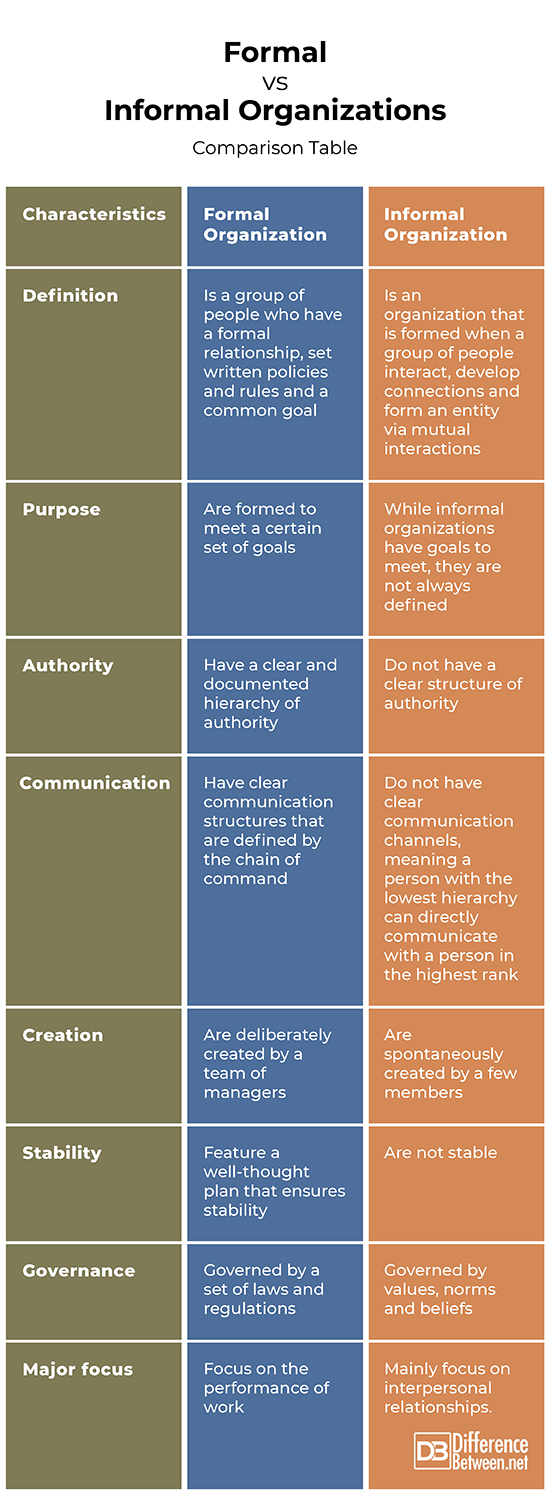Difference Between Formal and Informal Organization
We have all been part of an organization of some sort. And depending on how the organization ran its affairs, it could be an informal or a formal organization. There are different types of organizations. While some are formed to generate profit, others are formed for social reasons. Knowing the differences between formal and informal organizations helps individuals know which rules to follow and the point of authority. In this article, we will explore the difference between formal and informal organizations.

Formal Organization
A formal organization is a group of people who have a formal relationship, written policies and rules and an aim to achieve a common goal. Formal organizations are based on compliance. As such, there is a structure of authority.
The aim of a formal organization is the attainment of a set of goals. This could be anything from profit-making, providing education, the provision of medical assistance to a group of people to governance. In these settings, each member is assigned their tasks, as delegated by the persons in authority. Accountability is also a major feature in formal organizations whereby failure to achieve the set tasks attracts a reaction.
There are different types of formal organizations including line & staff, line, matrix, project management and functional organizations.
What are the features of a formal organization?
- Rules and regulations- Formal organizations have a set of rules and regulations that must be followed by everyone.
- Definite interrelationships- Formal organizations have mutual and definite interrelationships between the employees and customers that are established through the hierarchy.
- Stability- Formal organizations have stable working conditions since they must achieve a given goal.
- Division of work- Formal organizations feature division of labor through the set departments. This enhances structure and smooth running of an entity.

Informal organizations
This is an organization that is formed when a group of people interact, develop connections and form an entity via mutual interactions. Similar to formal organizations, informal organizations also have a structure that depends on the relation, norms and affiliations that the members have. Members also collaborate based on their capabilities and capacities to achieve the desired goal.
What are the features of an informal organization
- Non-formal communication channels- Most informal organizations have independent communications channels. And in most cases, they are informal. For instance, a call would suffice to pass communication from a person with the lowest rank to the person with the highest rank.
- No rules and regulations- An informal organization is run based on the personal interactions that people have.
- Instability- Informal organizations are not stable. As such, people can leave without many regulations.
Similarities between Formal and Informal Organization
- Both bring a group of people with a common goal together
Differences between Formal and Informal Organization
Definition
A formal organization is a group of people who have a formal relationship, set written policies and rules and a common goal. On the other hand, an informal organization is an organization that is formed when a group of people interact, develops connection and form an entity via mutual interactions.
Purpose
Formal organizations are formed to meet a certain set of goals. On the other hand, while informal organizations have goals to meet, they are not always defined.
Authority
While formal organizations have a clear and documented hierarchy of authority, informal organizations do not have a clear structure of authority.
Communications
Formal organizations have clear communication structures that are defined by the chain of command. On the other hand, informal organizations do not have clear communication channels, meaning a person with the lowest hierarchy can directly communicate with a person in the highest rank.
Creation
Formal organizations are deliberately created by a team of managers. On the other hand, informal organizations are spontaneously created by a few members.
Stability
Formal organizations feature a well-thought plan that ensures stability. On the other hand, informal organizations are not stable.
Governance
Formal organizations are governed by a set of laws and regulations. On the other hand, informal organizations are governed by values, norms and beliefs.
Major focus
While formal organizations focus on the performance of work, informal organizations mainly focus on interpersonal relationships.
Formal vs. Informal Organizations: Comparison Table

Summary of Formal vs. Informal organizations
A formal organization is a group of people who have a formal relationship, set written policies and rules and a common goal. Formal organizations are formed to meet a specific goal. As such, they tend to perform better compared to other types of organizations. On the other hand, an informal organization is an organization that is formed when a group of people interact, develops connection and form an entity via mutual interactions. While they have goals to meet, they are not always defined.
FAQs
Which one the formal or informal organization is better?
Formal organizations are better. This is because it is easy to achieve a given goal when it is clearly defined. And with the right leadership, formal organizations are more stable compared to informal organizations.
- Difference Between Profit Center and Investment Center - July 2, 2022
- Difference Between Anti-Trust and Anti-Competition - June 6, 2022
- Difference Between Stocktaking and Stock Control - June 6, 2022
Search DifferenceBetween.net :
Leave a Response
References :
[0]Kazuhito Isomura. Organization Theory by Chester Barnard: An Introduction. Springer Nature, 2020. https://books.google.co.ke/books?id=ikwFEAAAQBAJ&printsec=frontcover&dq=Difference+Between+Formal+and+Informal+Organization&hl=en&sa=X&ved=2ahUKEwix_bLzsYb2AhXmwQIHHdXVAk8Q6AF6BAgIEAI#v=onepage&q=Difference%20Between%20Formal%20and%20Informal%20Organization&f=false
[1]Tata Mcgraw-Hill. Qb In Business Studies Xii 7E (2009). Tata McGraw-Hill Education. https://books.google.co.ke/books?id=ZT9Q-DZ2jpQC&pg=PA67&dq=Difference+Between+Formal+and+Informal+Organization&hl=en&sa=X&ved=2ahUKEwix_bLzsYb2AhXmwQIHHdXVAk8Q6AF6BAgFEAI#v=onepage&q=Difference%20Between%20Formal%20and%20Informal%20Organization&f=false
[2]Lindsey J & Weisbord E. Managing People in Today's Law Firm: The Human Resources Approach to Surviving Change. Greenwood Publishing Group, 1995. https://books.google.co.ke/books?id=eAiuqRpbdFIC&pg=PA92&dq=Difference+Between+Formal+and+Informal+Organization&hl=en&sa=X&ved=2ahUKEwjKpcaCsob2AhWJOOwKHVHqCaI4ChDoAXoECAcQAg#v=onepage&q=Difference%20Between%20Formal%20and%20Informal%20Organization&f=false
